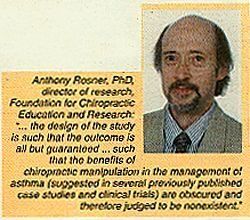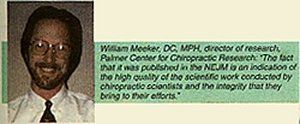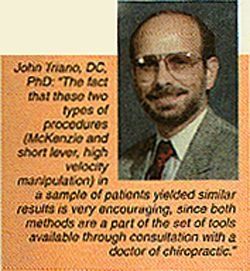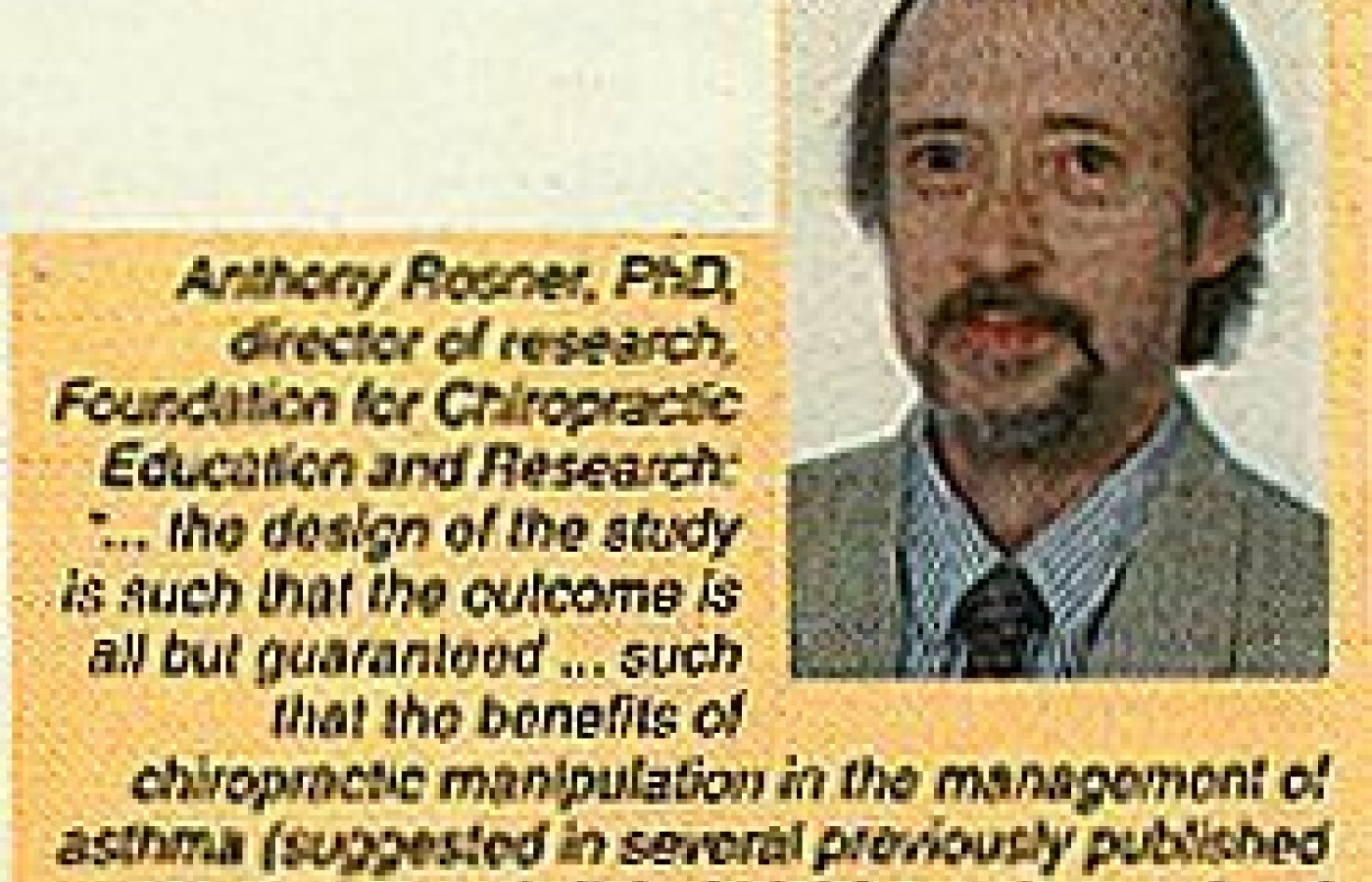Some doctors thrive in a personality-based clinic and have a loyal following no matter what services or equipment they offer, but for most chiropractic offices who are trying to grow and expand, new equipment purchases help us stay relevant and continue to service our client base in the best, most up-to-date manner possible. So, regarding equipment purchasing: should you lease, get a bank loan, or pay cash?
Chiropractic Studies Published in NEJM Foment Storm of Reactions
Unless you've been in the middle of the South Pacific on a sailboat without Internet access, you're probably heard quite a bit about the two studies published in the October issue of the New England Journal of Medicine (NEJM).



Headlines such as "Studies Cast Doubt on Chiropractic Treatments," "Human Touch Makes a Difference in Back-Care Study," and "Study Targets Worth of Chiropractic" have been a few of the headlines heralding the studies.
Interviews and comments have been sought from almost every chiropractic association and college. One noted chiropractic researcher was interviewed by three television stations, three newspapers and the Associated Press on the same day.
The studies have left many DCs feeling frustrated by their inconsistency with chiropractic clinical experience.
What follows is a brief review of each study and, perhaps more importantly, reaction from the chiropractic research community:
Study Number One: Chiropractic for Asthma1
This study was conducted by researchers from the Canadian Memorial Chiropractic College, the Los Angeles College of Chiropractic, St. Joseph's Hospital, and McMaster University in Ontario, Canada. The study was a "randomized controlled trial of spinal manipulation for children with mild or moderate asthma." A group of 91 children who still had symptoms after three weeks of medical therapy were randomly divided into two groups. Each group receive either "active" chiropractic manipulation or "simulated" chiropractic manipulation for four months. Each child continued to receive their regular medical care for their asthma while they were treated by one of 11 DCs based on location. The "primary outcome measure" was peak expiratory flow as measured by a bronchodilator. The children were tested before the study began, at two months and at four months.
Only 80 of the children (38 actively manipulated and 42 passively manipulated) had outcome data that could be evaluated. Both groups had small increases in peak expiratory flow: 7-12 liters per minute. Both groups showed a decrease in asthma symptoms and the use of beta-agonists and an increase in quality of life. But there was no significant difference between the groups.
Reactions from the Chiropractic Researchers
Anthony Rosner,PhD, director of education and research, Foundation for Chiropractic Education and Research (FCER):"A casual reading of the Balon and Aker study in the most recent issue of the New England Journal of Medicine suggests that chiropractic spinal manipulation provides no benefits to patients. What is overlooked are the facts that the design of the study is such that the outcome is all but guaranteed in advance, such that the benefits of chiropractic manipulation in the management of asthma (suggested in several previously published case studies and clinical trials) are obscured and therefore judged to be nonexistent. At a time when public interest in the application of alternative medicine is rising, it is regrettable that a study with such deep flaws in this field should have found its way to the lead position in such a prominent journal. Major deficiencies are summarized as follows:
"Lack of validity of the sham procedure:"
"With over 20 commonly used techniques and over 100 procedures overall described for chiropractic, there is a great deal of controversy as to what constitutes a proper sham or mimic treatment. Furthermore, with applications to no less than three regions of the patient (gluteal, scapular, and cranial), there is high probability that the sham procedure is invasive and overlaps to a large extent with the maneuvers chosen with the actual manipulation. The problem is compounded by the fact that nearly a dozen chiropractors had to be trained to perform such a procedure with no indication of standardization. The effect of all of this is to minimize or obscure the therapeutic effect that might be observed in an actual adjustment.
"Masking of possible effects by medication:"
"The fact that all patients have been medicated may be necessary from an ethical point of view, but it would be expected to mask the beneficial effects that might have been observed from spinal manipulation. The reader must be cognizant of the fact that the trial reports no benefits in addition to standard medication.
"Improvements over baseline values in both treatments:"
"The fact that there was significant improvement by intervening with the patients is demonstrated by the declines at two months and four months of both daytime symptom scores and the number of puffs per day of a beta-agonist, in addition to small increases in peak expiratory flow rates and pediatric quality of life scores in both groups. Such is to suggest that even in this trial there was significant improvement in the patients enrolled. What is not clear is which form(s) of intervention (global and/or manual) elicited responses and not that contact with the patient in the chiropractor's office under customary clinical conditions fails to provide additional benefits in addition to medication in the management of childhood asthma. It is simply an outmoded concept to assume that simply the presence or absence of cavitation constitutes the difference between chiropractic and no treatment.
"This presentation reflects the challenges and problems of properly designing a clinical trail which involves more than simply ingesting medications which can be fully masked. Practitioners cannot be blinded in the application of manual therapies, with the result that the authors have relied upon the patients incorrect answers to validate their ignorance of the type of treatment applied, despite the fact that nuances of emotion or expectations of the therapist would be expected to be conveyed to the patient.
"What is needed is far more sensitivity to the actual nature of asthma. Since it is exacerbated by stress by a plausible mechanism, one would hope in the future to measure suitable indicators of stress (such as cortisol levels) in assessing the outcomes of asthma treatments. The chiropractor remains an ideal candidate for the evaluation of such procedures, and it is hoped that the current trial appearing in the New England Journal of Medicine will not be in any way a deterrent to much-needed future research."
William Meeker, DC, MPH, director of research, Palmer Center for Chiropractic Research:
"On the asthma study, I would point out that chiropractic researchers designed and conducted the study, and that it was funded by the chiropractic profession. The fact that it was published in the NEJM is an indication of the high quality of the scientific work conducted by chiropractic scientists and the integrity that they bring to their efforts. It all is an indication that chiropractic is being taken seriously as a scientific health care project.
"Even though all of these children were under standard medical care, they still had problems, that is why they were allowed in the study. So, even though one might characterize these patients as treatment failures, they still had:
- decrease in symptoms;
- improvement in quality of life;
- decreased reliance on medication.
"Even though objectively measured lung function did not improve, the satisfaction with the chiropractic care was very high. There were no adverse effects of chiropractic care.
"This study supports anecdotal reports of chiropractors over the years.
"What if this was your child? Would you avoid chiropractic care because of this study?
"The fact that patients did improve begs the question of why. Simply to dismiss these effects as "placebo" and worthless is to disrespect these patients' experiences. If nothing else, this study highlights the importance of so-called non-specific effects of care how little we know about it."
John Triano, DC, PhD -- director of chiropractic division, Texas Back Institute and adjunct faculty, University of Texas Southwestern Medical Center, department of bioengineering:
"The work of Balon et al.2 represents an imposing effort in a complex and controversial area of study. As a clinical scientist with some experience in clinical trials (and tribulations), I have empathy for the investigators and their efforts. Unfortunately, because of methodologic flaws that could have been avoided by considering lessons learned by others, this study can not be generalized to the conclusions offered by these authors. There are equally acceptable alternative explanations for the observed result in contrast to the preferred hypotheses of the authors. In the least, the result is simply a statistical fluke and, at best, a comparison of similar treatments with (no surprise) similar results.
"The interventions for this trial are poorly quantified and no demonstration of true "sham" treatment is made. A randomized controlled trial is (by intent) a contrast of presumed effective versus inert procedures. The authors attempt to argue, 'We are unaware of published evidence that suggests that positioning, palpation, gentle soft-tissue therapy, or impulses to the musculature adjacent to the spine influence the course of asthma.' Technically, this may be correct for asthma specifically, however, animal models3,4 have demonstrated that minimal superficial and topical stimuli are able to alter bowel, heart, and intestinal function. Moreover, many of these functions have analogues confirmed in human physiology. There is no reason to assume a priori that pulmonary function is immune to these effects. Thus, the authors have failed to demonstrate that their alternative treatment was inert. We were faced with a similar quandary in our publication on low back pain in Spine. We quantified exacting comparisons of treatment technique and made biomechanical and physiologic measurements that demonstrated the "inertness" of the treatment mimic/sham. Similar technical measures could have been made by Balon et al. but were ignored.
"While the study has significant power as a result of sample size, the criteria for comparison was based on an arbitrary set of dosage and duration of treatment without any consideration to the question of threshold effects. It is possible that the differences observed at two months that disappear at four are a reflection of the common mechanical action of the two procedures. The different scores parallel the arbitrary rate of reduction in frequency (dosage) in treatment. This factor has been ignored and remains unexplained except by a casual reference to placebos. Studies in the early 1990s6,7 demonstrated that manipulation loads to the spine were capable of altering phagocytic respiratory bursts. Moreover, a minimum threshold load was necessary. Of interest is the fact that no "release" or "pop" associated with joint cavitation was necessary to achieve the physiologic changes. The only requirement was applying spinal load sufficient to reach the threshold values. As no measures of load were made by Balon et al, they can not scientifically make the assertions that either the treatments were different or that they were not physiologically active.
"In summary, to be done effectively, such studies as the randomized trial for treatment of asthma using manipulation must produce the scientific methods necessary to achieve the claimed levels of power and methodologic rigor. The work of Balon et al. fails to meet the mark and has not been helpful in decreasing the controversy. It has, unfortunately, added to the list of studies interpreted far beyond the legitimate bounds of their scientific limitations: a harsh criticism often levied by political medicine against chiropractors."
The Second Study: Chiropractic vs. McKenzie8
Three-hundred-twenty-one adults with "low back pain that persisted for seven days after a primary care visit" were randomly assigned to either one specific chiropractic manipulation, the McKenzie method of physical therapy or were given an educational booklet on back pain (considered a "minimal intervention"). Patients in the "one manipulation" group were not allowed to receive physical therapy. A maximum of nine visits (as determined by the practitioner) to the chiropractor or the physical therapist were provided over one month. The patients were followed for two years. Symptoms were measured on an 11-point scale with dysfunction measured on a "24-point Roland disability scale." Subjects were tested at baseline, four weeks, twelve weeks, one year and two years.
The chiropractic group showed less symptoms than the booklet group at four and twelve weeks, but these differences were small, and judged to be not significant after "transformations of data to adjust for their non-normal distribution." The booklet group showed greater dysfunction than the chiropractic and McKenzie groups that approached significance at one year.
No significant differences were found between the chiropractic and McKenzie groups for all outcomes including recurrences of back pain, reduced activity and days missed work. Approximately 75 percent of the subjects in both "therapy groups" rated their care as excellent or very good, compared to only 30 percent in the booklet group. The average cost of care over the two-year period was $429 for the chiropractic group, $437 for the McKenzie group and $153 for the booklet group.
Reactions from the Chiropractic Researchers
Anthony Rosner, PhD -- research director, Foundation for Chiropractic Education and Research."The Cherkin study which has just appeared in the New England Journal of Medicine and appears to have taken the media by storm is an inaccurate and unfortunate representation of the patients who normally seek chiropractic care for low-back pain. It underscores the dangers of generalizing the results of randomized clinical trials which themselves represent a specialized application of therapies under restrictions that are not necessarily indicative of either the actual therapists or patients whom they see. Worse, its designs are so numerous and serious, as will be summarized below, that its validity is compromised to the point of misleading the reader as to what is actually shown in the trial."
"Validity of the intervention:"
"To begin, one must be aware that several chiropractic techniques are applicable to the management of low-back pain, some of which are low-force (Logan basic technique, flexion-distraction, use of a drop table of traction). In this trial only one high-velocity technique (side-posture) was applied, and this may not be equally effective for all patients (particularly older people). Furthermore, important ancillary procedures that are intrinsic to the chiropractic visit appear to have been denied to patients; in particular, (a) extension exercises were denied, and (b) patients most likely were not given any literature, even though these two options might be considered to be part of a customary chiropractic regimen for office visits. The implication is that both these elements were only permitted in the other two arms (educational booklet and McKenzie method) of the trial reported. In short, chiropractic treatment in this particular trial appears to be only a pale shadow of the actual therapy administered to patients in the real world. The fact that back pain recurrences as reported by the authors were 50% by the end of the first year and 70% by the end of the second year confirms this point of view, not only for chiropractic but for the McKenzie physical therapy modality as well.
"Baseline characteristics:"
"Baseline values regarding severity among the three groups tested appear to create a bias in the outcomes. To begin, the chiropractic group shows the highest tendency in percentages of patients who, due to LBP and prior to their therapy, encounter (a) greater than one day of bedrest (35% vs 24% and 22% for the McKenzie and booklet groups), (b) more than one day of work lost (39% vs. 41% and 30% for the McKenzie and booklet groups), and (c) greater than one day of restricted activity (72% vs 65% and 52% for the McKenzie and booklet cohorts).
"Secondly, the initial bothersome (symptoms) and Roland-Morris disability scores of 4 and 7-8 are substantially below the respective values of 6-7 and 10 which are more frequently observed in trials involving significant low-back pain. This means that any observed changes are compressed within an artificially narrow range and that statistical variations become more disruptive. The effect of both of these aberrations is to compromise the monitoring of back pain resolution.
"In summary, the study is a poor representation of therapies as applied to the live patient in the physician's office. If left unanswered, these inquiries would appear to be of sufficient import as to render the data seriously compromised and the study as a whole unreliable. It would be a grievous error at this point to accept the study as Gospel, and the authors are invited to respond."
William Meeker, DC, MPH: -- director of research, Palmer Center for Chiropractic Research
"On the low-back pain study, it is gratifying to see experienced health services researchers conducting studies on one chiropractic procedure, spinal manipulation, especially supported by a Federal agency, the Agency for Health Care Policy and Research.
"Dr. Cherkin admits that the McKenzie treatment and chiropractic both demonstrated statistically significant advantages compared to the patient booklet at 4 weeks and probably at 12 weeks. Look at Table 3. While he calls this difference marginal, I suggest that the difference is very important if you're a patient with back pain who has been having a hard time with pain and daily activities. As well, at one year, there were statistically significant advantages to both the physical treatments.
"The McKenzie therapists were an elite trained group, trained by Robin McKenzie himself just prior to this study, and employed by the HMO. On the other hand, the chiropractors, as competent and experienced as they were, did not receive any high level pressurized training prior to the study.
"Finally, patients were much more satisfied with their care from the PTs or DCs compared to those not receiving care. Despite protestations, this does have very important implications.
"I find it hard to believe that patients will now be satisfied to stay home instead of seeking care from the doctor or therapist simply because of this study. About 80% of Americans will experience back pain at some point in their lives. About 40% of all back patients seek care from chiropractors, and about 50% of a chiropractors' caseload is low-back pain."
John Triano, DC, PhD -- director of chiropractic division, Texas Back Institute and adjunct faculty, University of Texas Southwestern Medical Center, department of bioengineering:
"The results of the work of Cherkin et al. are not surprising when one looks at the biomechanical features consistent between the procedures which originated with physical therapist Robin McKenzie in New Zealand, and with chiropractic procedures of high velocity, low-amplitude manipulation. Both of these methods are designed to alter the stress distribution and change the biomechanical behavior or the motion segment including the disc. Based upon empirical results, chiropractic physicians have long incorporated the use of McKenzie procedures within their full armamentarium of methods for treating spine related disorders.
"There is one area of concern in the research methods that further raises expectation of similar results between the two treatment methods. Treatment, successfully administered, is based on patient selection from physical exam and historical characteristics. Since the patients in this study were triaged based solely on persistence of pain greater than seven days, the group heterogeneity was assured. Treatment, then, was given to a heterogeneous population without regard to standard assessment.
"What is unfortunate is that circumstances in Washington state which permitted a contrasting of treatment procedures under the heading of occupational titles. Physical therapy is not McKenzie procedure. Chiropractic is not restricted to short lever, high velocity manipulation. The true comparison was between two mechanical procedures with essentially the same objective. As a result, the fact that these two types of procedures in a sample of patients yielded similar results is very encouraging since both methods are a part of the set of tools available through consultation with a doctor of chiropractic."
Final Thoughts
These two studies have been published at a time when the chiropractic profession has the scientific expertise and credibility to effectively critique and expose their flaws. The comments of our researchers have been used in numerous press releases, interviews and responses to the media. Dr. Triano's comments have been submitted to the editor of the NEJM for publication.
Keeping it all in perspective, Dr. Meeker makes these final comments:
"Both studies are intriguing and welcome additions to the scientific literature but are not definitive and final by any means. They each leave unanswered a number of questions, which further research is likely to address. Research is not a project but a process. The chiropractic profession supports continued scientific evaluations of its procedures, just as it does for all medical and health care methods, many of which also suffer from a lack of definitive research proving benefits."
References:
- Balon J, Aker PD, Crowther ER, Danielson C, Cox PG, O'Shaughnessy D, Walker C, Goldsmith CH, Duku E, Sears MR. A comparison of active and simulated chiropractic manipulation as adjunctive treatment for childhood asthma. N Engl J Med 1998;339:1013-20.
- Ito K, Sato A, Shimamura K, Swenson R. Convergence of noxious and non-noxious cutaneous afferents and baroreceptor afferents onto single adrenal sympathetic neurons in anesthetized rats. Neurosci Res 1(2):105-116, 1984.
- Sato A, Swenson RS. Sympathetic nervous system response to mechanical stress of the spinal column in rats. JMPT 7(3):141-147, 1984.
- Triano JJ, McGregor M, Hondras M, Brennan P. Manipulation therapy vs. education programs in chronic low-back pain. Spine 20(8):948-955, 1995.
- Triano JJ, Schultz AB. Transmitted loads during lumbosacral SMT. Spine 22(17):1955-1964, 1997.
- Brennan PC, Kokjohn K, Klatinger CJ, Lohr GE, Glendening C, Hondras MA, McGregor M, Triano JJ. Enhanced phagocytic cell respiratory burst induced by spinal manipulation: Potential role of substance P. JMPT 14(7):399-408, 1991.
- Brennan P, Triano JJ, McGregor M, Kokjohn K, Hondras M, Brennan D. Enhance neutrophil respiratory burst as a biological marker for manipulation forces: Duration of the effect and association with substance P and tumor necrosis factor. JMPT 15(2):83-89, 1992.
- Cherkin DC, Deyo RA, Battie M, Street J, Barlow W. A comparison of physical therapy, chiropractic manipulation, and provision of an educational booklet for the treatment of patients with low-back pain. N Engl J Med 1998;339:1021-9.



